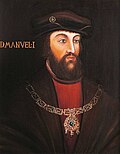| King of Portugal and the Algarves (1139–1910) | |
|---|---|
 | |
 Manuel II , last King of Portugal | |
 Dom Duarte Pio, Duke of Braganza, claimant of the dormant throne | |
| Details | |
| Style | His/Her Most Faithful Majesty |
| First monarch | Afonso I |
| Last monarch | Manuel II |
| Formation | 25 July 1139 |
| Abolition | 5 October 1910 |
| Residence | Royal residences in Portugal |
| Pretender | Duarte Pio, Duke of Braganza |
This is a list of Portuguese monarchs who ruled from the establishment of the Kingdom of Portugal, in 1139, to the deposition of the Portuguese monarchy and creation of the Portuguese Republic with the 5 October 1910 revolution.
Contents
- House of Burgundy (Afonsine Dynasty, 1139–1383)
- House of Aviz (Johanine Dynasty, 1385–1580)
- House of Habsburg (Philippine Dynasty, 1581–1640)
- House of Braganza (Brigantine Dynasty, 1640–1910)
- Length of reign
- See also
- Notes
- References
- Further reading
- External links
Through the nearly 800 years in which Portugal was a monarchy, the kings held various other titles and pretensions. Two kings of Portugal, Ferdinand I and Afonso V, claimed the crown of Castile and waged wars in order to enforce their respective claims. Ferdinand I managed to be recognized as King of Galiza in 1369, although his dominance of the region was short-lived. When the House of Habsburg came into power, the kings of Spain, Naples, and Sicily also became kings of Portugal. The House of Braganza brought numerous titles to the Portuguese Crown – some honorary, such as the attribution of the title of Rex Fidelissimus (His Most Faithful Majesty), and royal titles, such as King of Brazil and then de jure Emperor of Brazil.
After the demise of the Portuguese monarchy, in 1910, Portuguese monarchists launched a counter-revolution known as the Monarchy of the North, in 1919, though the attempted restoration only lasted a month before destruction. With Manuel II's death, the Miguelist branch of the house of Braganza became the pretenders to the throne of Portugal, and have all been acclaimed king of Portugal by monarchist groups.
Throughout Portugal's history as an independent kingdom, it was ruled by a total of 4 royal houses:
- House of Burgundy (or Afonsine Dynasty, 1139–1383)
- House of Aviz (or Johanine Dynasty, 1385–1580)
- House of Habsburg (or Philippine Dynasty, 1581–1640)
- House of Braganza (or Brigantine Dynasty, 1640–1910)
The House of Burgundy actually held the title of Count of Portugal beginning in 1096. However, all but the most comprehensive lists of Portuguese monarchs exclude such pre-independence figures.






































